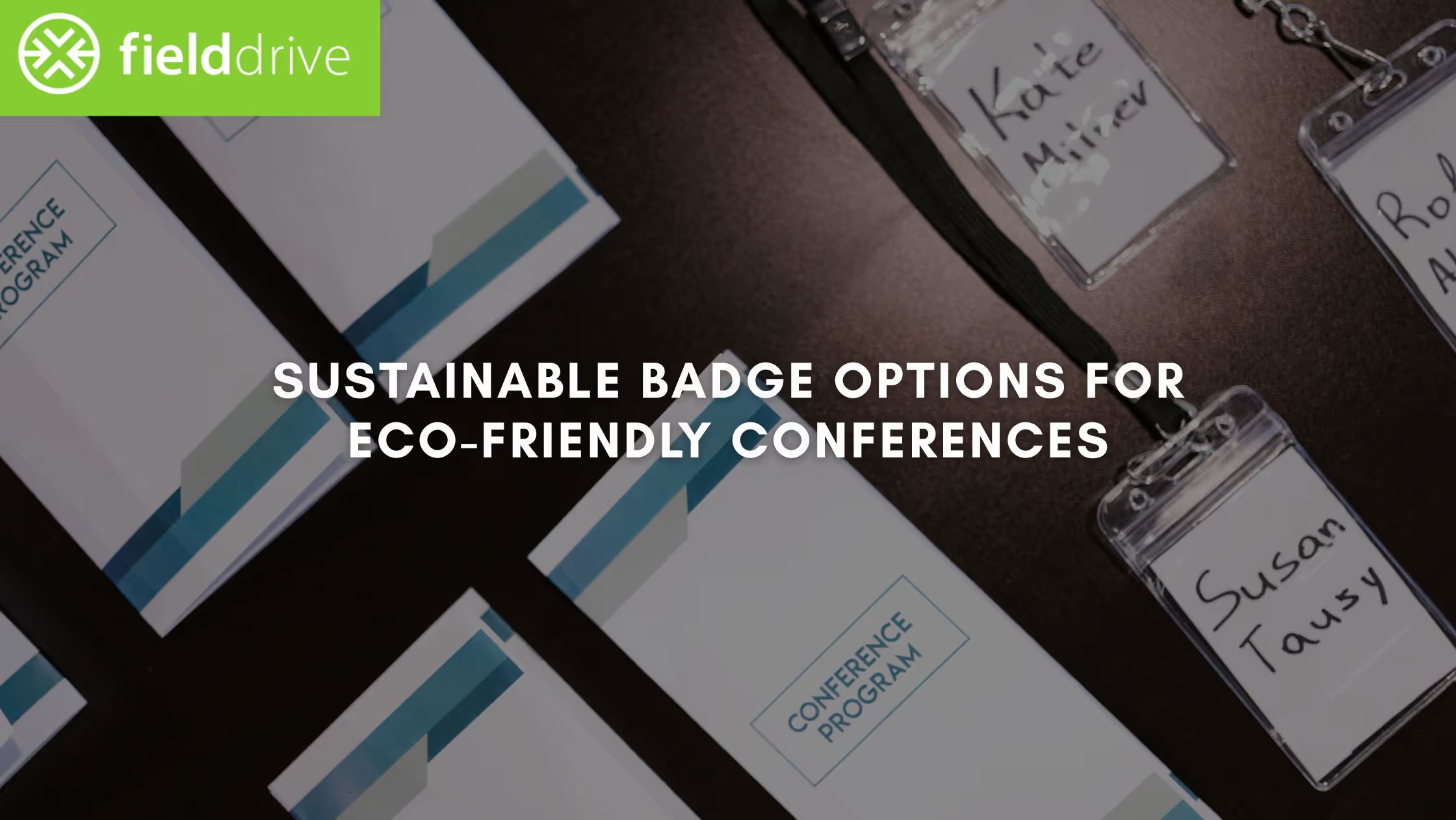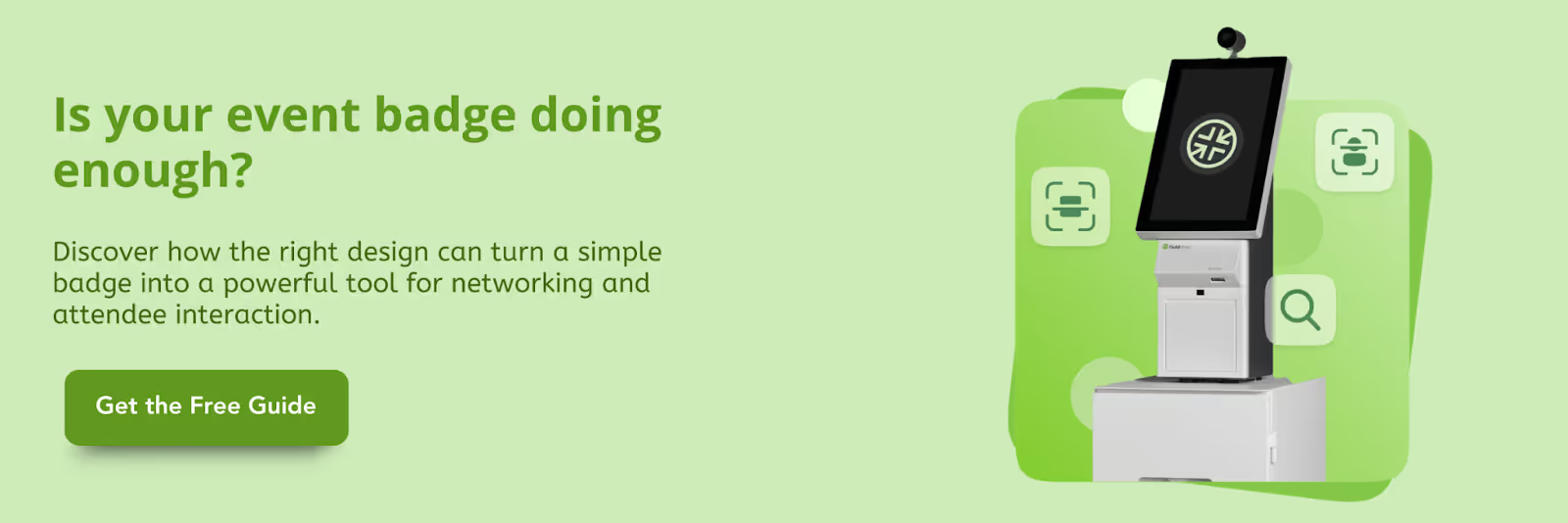Sustainable Badge Options for Eco-Friendly Conferences
Explore sustainable conference badges for eco-friendly events. Learn how to reduce your environmental impact with green badge options at conferences.

CONTENT
Are you looking to reduce event waste and make your conferences more sustainable with eco-friendly badges? We get it, organizing an eco-conscious event isn’t always easy. Associations like yours are under increasing pressure to meet sustainability goals while delivering an outstanding attendee experience.
At the same time, members are becoming more mindful of the environmental impact of events. In fact, 77% of individuals are eager to learn about sustainable lifestyles and are drawn to brands that reflect those values.
This blog will walk you through sustainable badge options, their impact on your event’s eco-footprint, and how to implement them effectively. You’ll also learn best practices and discover material options that can help reduce waste while keeping your conference experience top-notch.
Key Takeaways
- Sustainable conference badges are made from biodegradable, recyclable, or upcycled materials, supporting eco-conscious goals.
- Implement on-demand badge printing to minimize overproduction and waste, while offering personalized attendee experiences.
- Utilize eco-friendly options, such as plantable seed paper, bamboo, or fabric, to enhance sustainability and create lasting memories.
- Replace plastic badge holders with biodegradable or fabric alternatives and promote recycling at your event.
- Eco-friendly practices such as using soy-based ink and recycled materials further minimize your event’s environmental impact.
4 Essential Sustainability Factors for Eco-Friendly Badges
When selecting sustainable badges, understanding key sustainability factors is essential for making the right choice. These factors ensure your event reduces waste while still providing a high-quality, memorable experience for attendees.
- Biodegradable Materials: Biodegradable badges naturally break down, reducing their long-term environmental impact. Select materials such as plant-based plastics or compostable paper for badges that break down over time.
- How it works: Badges made from biodegradable materials decompose in landfills, leaving a smaller environmental footprint.
- Recyclable Materials: Recyclable badges can be reused, keeping materials out of landfills. Select cardboard, recycled plastics, or paper to ensure the badges can be recycled after the event.
- How it works: By choosing recyclable materials, badges can be reused or repurposed, helping to minimize waste.
- Upcycled Materials: Upcycled badges utilize materials that have been repurposed from previously manufactured products. This reduces the need for new resources, contributing to a more circular economy.
- How it works: Upcycled badges give old materials a second life, preventing waste and conserving resources.
- Organic Materials: Organic materials, such as plant fibers or wood-based paper, are renewable and naturally decompose. These materials are an eco-friendly option for badges that don’t require chemical processes for production.
- How it works: Organic materials are biodegradable and often come from renewable sources, reducing environmental impact.
By understanding these four essential sustainability factors, you can choose eco-friendly badges that align with your association’s sustainability goals.

Best Practices for Implementing Sustainable Conference Badges
Adopting sustainable badge practices is essential for reducing your event's environmental footprint. These best practices will not only minimize waste but also align your event with eco-conscious values. Let’s explore how to implement each of these strategies for a greener, more sustainable conference experience.
1. Print On-Demand Badges
Pre-printing badges can lead to unnecessary waste, especially if attendees don't show up. Printing badges as attendees arrive reduces overproduction and ensures that you only print what you need.
Best Practices:
- Use high-speed printers for on-demand badge printing.
- Avoid pre-printing badges for a flexible, waste-free process.
- Offer digital badges for virtual attendees.
Pro Tip: Consider using interactive check-in kiosks like the one provided by fielddrive to instantly print personalized badges, reducing the need for extra printing.
2. Eliminate Plastic Badge Holders
Plastic badge holders contribute significantly to waste and are difficult to recycle. Opt for alternatives like paper or eco-friendly biodegradable materials that minimize environmental impact.
Best Practices:
- Choose biodegradable or paper badge holders.
- Consider clip-on lanyards or fabric holders for added durability.
- Avoid excessive plastic materials altogether.
Pro Tip: Switch to recyclable cloth lanyards that attendees can keep, reducing waste and increasing event sustainability.
3. Remove Inserts When Not in Use
Leaving inserts in badge holders can damage both the insert and the holder. Removing them when not in use extends the lifespan of materials and reduces unnecessary waste.
Best Practices:
- Only insert necessary attendee information when required.
- Use air pocket badge holders to slide inserts in and out easily.
- Avoid leaving inserts in holders after the event ends.
Pro Tip: Store unused badge inserts separately in eco-friendly containers to ensure they remain in good condition for future use.
Also read: How to Design Tamper-Proof Badges to Ensure Event Safety?
4. Opt for Biodegradable Seed Paper Badges
Seed paper badges are a creative solution for biodegradable waste. These badges can be planted in soil to grow flowers or herbs, reducing landfill waste and creating lasting memories.
Best Practices:
- Choose plantable seed paper for biodegradable badges.
- Offer attendees the chance to grow flowers as a memento.
- Include instructions on how to plant badges.
Pro Tip: Consider offering seed paper bookmarks as a more practical and eco-friendly option that attendees can use after the event.

5. Use Eco-Friendly Ink for Printing
Traditional ink can release harmful chemicals into the environment. Opt for eco-friendly inks, such as soy-based ink, which are less harmful and more sustainable.
Best Practices:
- Choose soy-based or water-based inks for your printing needs.
- Ensure the ink used is low in volatile organic compounds (VOCs).
- Encourage suppliers to adopt green printing methods.
Pro Tip: For a unique twist, incorporate recycled paper labels printed with soy-based ink on your badges, giving them an eco-friendly, branded touch that stands out.
6. Choose Recycled and Recyclable Materials
Using recycled materials for badges and lanyards reduces the need for new resources. Choosing materials that are recyclable at the end of their life further minimizes environmental impact.
Best Practices:
- Use recycled paper or plastic for badges.
- Ensure lanyards and holders are made of recyclable materials.
- Partner with vendors that offer closed-loop recycling systems.
Pro Tip: Use recycled fabric lanyards for added durability and style, ensuring they can be reused or recycled later.
fielddrive makes it easier than ever to print biodegradable badges on-demand, reducing waste while enhancing attendee experience. Their real-time badge printing solutions, along with sustainable materials, ensure your event runs smoothly while supporting your green initiatives.
Also read: 15 Great Ideas to Make Your Sustainable Event a BIG HIT
Popular Materials for Sustainable Conference Badges
When choosing sustainable materials for conference badges, it's important to focus on options that are both eco-friendly and durable. Let’s explore some of the most popular materials that help reduce waste and enhance your event’s sustainability efforts.
- Recycled Paper: Recycled paper is a widely used sustainable material for badges. It offers a simple, eco-friendly option for conferences.
- When it's best for: Short-duration events or conferences where badges are only used for a limited time.
- Biodegradable Plastic: Made from plant-based polymers, biodegradable plastics decompose naturally, minimizing long-term waste.
- When it's best for: Events that require durable badges but still aim to reduce environmental impact.
- Seed Paper: Seed paper badges are made from biodegradable paper embedded with seeds. They can be planted to grow flowers or herbs after the event.
- When it's best for: Eco-conscious conferences or green events looking to leave a lasting, sustainable impact.
- Upcycled Materials: Using materials like repurposed fabrics, old banners, or waste plastics, upcycled badges give new life to existing resources.
- When it's best for: Trade shows, expos, or corporate events where reusing materials can align with event themes or branding.
- Bamboo: Bamboo is a renewable, biodegradable material known for its strength and minimal environmental impact. It can be used for both badges and lanyards.
- When it's best for: Corporate events or corporate conferences that need both durability and sustainability.
- Fabric: Eco-friendly fabrics, such as organic cotton or hemp, can be used for badges or lanyards, offering a more sustainable alternative to plastic.
- When it's best for: Long-term events or festivals, where reusable materials are key for engagement.
Select the option that best suits your event’s needs, while ensuring that sustainability remains a top priority.

Conclusion
Sustainability is becoming a key focus in conference planning, and sustainable badges are an easy way to make a significant impact. By choosing biodegradable, recyclable, and upcycled materials, you can minimize waste, enhance the attendee experience, and showcase your commitment to the environment.
fielddrive stands out by offering on-demand, eco-friendly badge printing that aligns perfectly with sustainability goals. With customizable, biodegradable badges and real-time printing, fielddrive ensures your event is green without compromising on quality.
Book a demo with fielddrive today and start transforming your events with sustainable badge solutions that make a difference.
FAQs
1. Are Conference Badges Recyclable?
Yes, many badges are recyclable, especially those made from recycled materials such as paper, biodegradable plastics, and cardboard. Check materials before use to ensure they’re properly recyclable.
2. How Can I Run a Sustainable Conference?
To run a sustainable conference, focus on eco-friendly badges, digital materials instead of printed ones, and sustainable venues. Prioritize recycling, minimize waste, and encourage greener travel options.
3. What Are Eco-Friendly Symbols?
Eco-friendly symbols represent materials or practices that are environmentally safe. Common symbols include the recycling logo, compostable marks, and certifications such as Fair Trade and Forest Stewardship Council (FSC) certification.
4. How Can I Promote Eco-Friendly Habits at My Event?
Promote eco-friendly habits by encouraging digital event guides, offering reusable items, reducing plastic use, and setting up recycling stations. Use sustainable badges and encourage the use of public transportation or carpooling.
Want to learn how fielddrive can help you elevate your events?
Book a call with our experts today



.png)
.svg)
.svg)
.svg)

.svg)